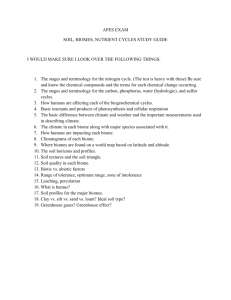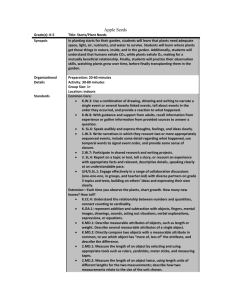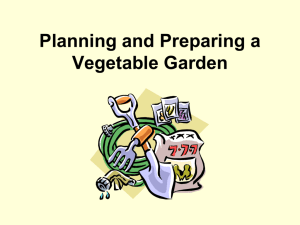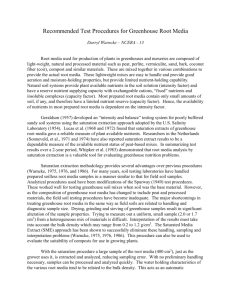From Soil to Table
advertisement
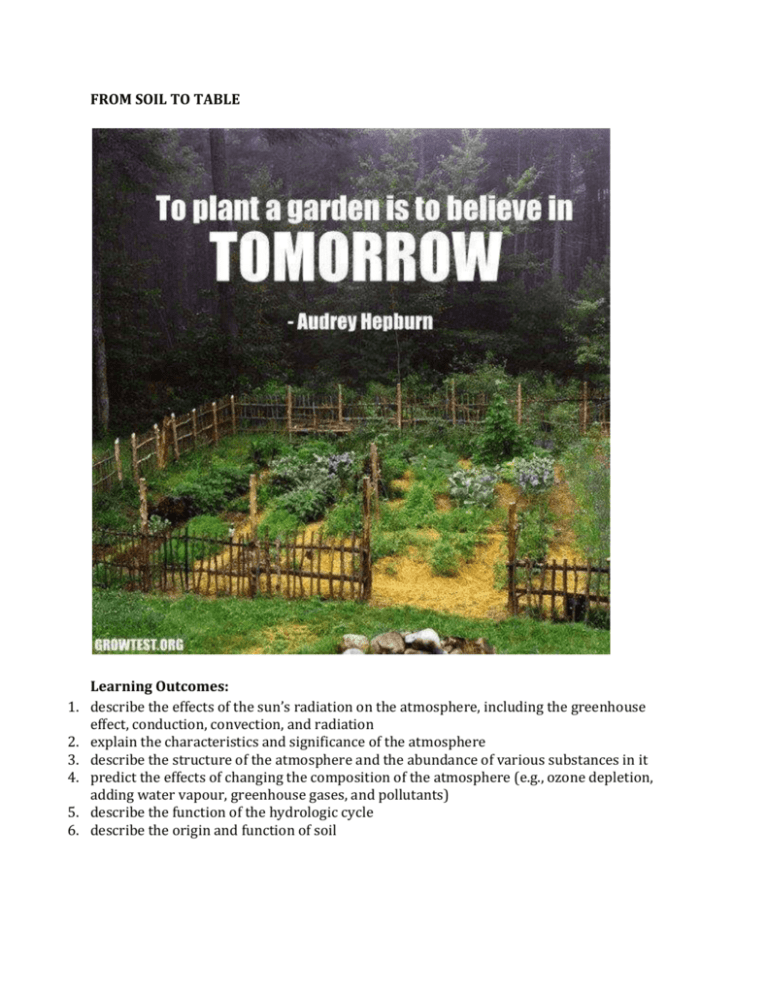
FROM SOIL TO TABLE 1. 2. 3. 4. 5. 6. Learning Outcomes: describe the effects of the sun’s radiation on the atmosphere, including the greenhouse effect, conduction, convection, and radiation explain the characteristics and significance of the atmosphere describe the structure of the atmosphere and the abundance of various substances in it predict the effects of changing the composition of the atmosphere (e.g., ozone depletion, adding water vapour, greenhouse gases, and pollutants) describe the function of the hydrologic cycle describe the origin and function of soil Place-making outcome: 1. Develop a sense of relation (biophilia) by creating a special place (garden bed). Thesis: Applying the principles of IEE through the Market Garden at David Thompson Secondary will improve pupils’ academic confidence. Unit Plan: I wonder what type of growing conditions (soil, water, air light) would produce best/most food? Everybody eats. If we did not, we could not live. It would be desirable then to be able to grow some of what we eat. Planting is a place-making activity. It connects us to the soil, the air, water and food. Pupils will work in pairs to plant a crop under 2 conditions, greenhouse seeding and direct bed seeding to determine which produces better crop yield. Each pair will choose a different type of seed to grow. There are 15 pupils in the class. 1. What do I already know about growing food? (Tell me the story of something you have planted before or something an elder has taught you about planting.) 2. Select seeds. What factors must be considered for selecting crops? (Time of year, suitability to climate, taste, growing time) 3. Determine which soil is best for that type of plant. (Organic or inorganic fertilizer) 4. Research growing conditions (water, light, etc) (Direct bedding or greenhouse) 5. Planting: In pairs, plant your seeds to desirable depth and distance between seeds in pots (greenhouse) or in beds outside. 6. Watering/air 7. Weeding, tending, watching. (Does talking/singing to plants help?) 8. Produce a report. Use your journal (plain and lined paper, hard backing) for data collection. What are you measuring? (Height, breath etc) Anecdotal evidence, drawing Time: 5 days in March (4, 6, 10, 12, 14) 2 weeks spring break 5 days in April (1, 3, 7, 9, 11) - for a total of 4 weeks Materials needed: 7 different kinds of seeds 7 pots Soil – organic Fertilizer Journals Measuring tapes or rulers Cameras Measuring cylinders Balances 1. Heroic Quality Soil-air-water-light work together to sustain life Plants – turning inorganic into organic (a thing animals cannot do) Plants: Life sustainers Lesson 1: Plants juggle water/air/light to sustain life. (Teach juggling using scarves) Should we honour/respect/nurture plants or should we enslave them? Analogous to pets – how do we feel about our pets? Are they a part of a caring, mutually beneficial relationship in your family or are they your property to show off or dominate? Should we nurture plants as they nurture us? 2. Humanizing the Context: Tell the story of the person who taught you to grow plants. Who were the first farmers? 10,000 BCE or 12,000 years ago a series of profound changes occurred in the way humans lived. They are called the Neolithic Revolutions and the domestication of plants and animals (farming) was one of those revolutions. It changed everything about the way humans lived – we went from nomadic hunter/gatherers to sedentism (settling down/staying in one place). We began cultivating plants and animals. This new lifestyle spread from the region covering the Eastern Mediterranean to China all over the world. Although it is a more efficient way to feed ourselves, we were also transformed from ‘walkers’ to ‘couch potatoes’. We lost some of the benefits of being nomadic and inherited a slew of health problems by limiting our diet to what we could cultivate and store. Can we turn the clock back? Can we improve our farming practices to diversify our diet? Can we choose plants to cultivate that are appropriate for this soil and climate (airwater-light)? What is the effect of different soils on plant growth? Investigate the composition of soil – pH, layers, turbidity How do we measure plant growth? (height of stem; breath of leaves; # of leaves; colour of leaves; flowers) Monitoring other variables (volume of water; mass of soil; light meter) 3. Sense of Place Through daily interaction with the plants in the greenhouse and garden bed, students may develop an emotional connection to the garden that they have created. Will this attachment create a greater feeling of academic confidence in them?







